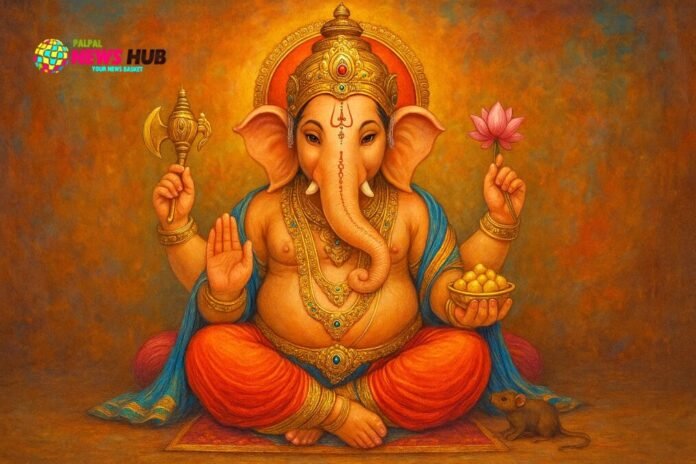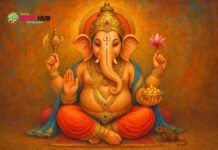
In the vast pantheon of Hindu deities, few figures command as much universal reverence and affection as Lord Ganesha, the beloved elephant-headed god who stands as one of the most recognized and worshipped divinities in Hinduism. Known by numerous names including Ganapati, Vinayaka, and Vighnaharta, Ganesha occupies a unique position in Hindu mythology as the remover of obstacles, the patron of arts and sciences, and the lord of beginnings. His distinctive appearance characterized by an elephant head, a rotund belly, and a gentle demeanor has made him not only a central figure in religious practices but also a symbol of wisdom, prosperity, and divine intervention that transcends geographical and cultural boundaries.
The significance of Lord Ganesha extends far beyond his role as a popular deity; he represents fundamental principles of Hindu philosophy and spirituality that have guided millions of devotees for centuries. As the son of Lord Shiva and Goddess Parvati, Ganesha embodies the harmonious union of power and compassion, destruction and creation, making him an integral part of Hindu cosmology. His worship is considered essential before undertaking any new venture, whether spiritual or material, as he is believed to clear the path of obstacles and ensure success in all endeavors.
Origins and Birth Stories in Hindu Scriptures
The Mythological Birth
The birth of Lord Ganesha is one of the most fascinating and symbolically rich narratives in Hindu mythology, with several versions documented across various Puranas and sacred texts. The most widely accepted account, found in the Shiva Purana and other major scriptures, tells of how Goddess Parvati created Ganesha from turmeric paste while preparing for her bath. Desiring privacy and a loyal guardian, she breathed life into this figure, creating a beautiful young boy endowed with extraordinary qualities of strength and devotion.
The pivotal moment in this narrative occurs when Lord Shiva returns home to find his path barred by this unknown youth. Ganesha, dutiful to his mother’s instructions and unaware of Shiva’s identity, refuses to allow entry. This confrontation leads to a fierce battle between father and son, culminating in Shiva severing Ganesha’s head in divine fury. The story takes a redemptive turn when Parvati’s grief threatens the very fabric of creation, forcing Shiva to restore his son’s life by replacing the severed head with that of an elephant, thus giving birth to the unique form we recognize today.
Alternative Origin Stories
Hindu scriptures present several alternative versions of Ganesha’s origin, each carrying distinct theological implications. One version suggests that Shiva himself created Ganesha to serve as an obstacle-creator for those who needed to be checked in their wrongdoing. Another account from the Brahma Purana describes how all gods and sages approached Shiva requesting a divine being who would oppose the perpetration of sins, leading to Ganesha’s creation as a cosmic balance.
These varied narratives reflect the rich tapestry of Hindu thought, where multiple truths can coexist and serve different spiritual purposes. The elephant head, consistently present across all versions, symbolizes wisdom, memory, and the ability to overcome the largest obstacles, making it a perfect representation of Ganesha’s divine functions.
Scriptural Foundations and Textual References
Vedic and Puranic Literature
While Lord Ganesha’s presence in early Vedic literature is relatively subtle, his prominence grows significantly in later texts. The earliest references to Ganesha appear between the 1st century BCE and 2nd century CE, with his worship becoming increasingly prominent during the Gupta period. The Ganesha Purana, one of the most important texts dedicated to him, presents a comprehensive theology that establishes Ganesha as both a personal deity and a cosmic principle.
The Ganesha Purana is organized into two major sections: the Krida-khanda (155 chapters focusing on mythology and genealogy) and the Upasana-khanda (92 chapters dedicated to theology and devotion). This text, along with the Mudgala Purana, Brahma Purana, and Brahmanda Purana, forms the core scriptural foundation for Ganesha worship, each presenting different aspects of his divine nature.
The Ganapati Atharvashirsha Upanishad
Perhaps the most philosophically profound text dedicated to Ganesha is the Ganapati Atharvashirsha Upanishad, a minor Upanishad from the Atharva Veda that establishes Ganesha’s identity as the Supreme Brahman. This sacred text transcends mere devotional worship to present Ganesha as the ultimate reality, declaring him to be Sat-Chit-Ananda (Existence-Consciousness-Bliss).
The Upanishad identifies Ganesha with the primordial sound “Om,” positioning him as both the creator and the essence of the Vedas themselves. It presents him as both saguna (with attributes) and nirguna (beyond attributes), serving as a bridge between devotional practice and philosophical realization. This text is particularly significant for the Ganapatya tradition, which recognizes Ganesha as their primary deity and the supreme cosmic principle.
Symbolism and Iconography
The Elephant Head: Symbol of Wisdom
The most distinctive feature of Lord Ganesha his elephant head carries profound symbolic meaning in Hindu iconography. Elephants in Hindu culture are revered for their intelligence, memory, and discriminating wisdom, qualities that make them ideal symbols for Ganesha’s role as the bestower of knowledge and remover of ignorance. The large head represents the capacity for great thinking and the ability to process complex spiritual truths.
In traditional Hindu thought, elephants are also known as path-makers in dense forests, clearing the way for other animals to follow. This natural behavior perfectly parallels Ganesha’s function as the remover of obstacles, clearing spiritual and material hindrances from the paths of his devotees. The symbolism extends to his role as the first deity invoked in any Hindu ritual, ensuring that the spiritual journey proceeds without impediments.
Physical Attributes and Their Meanings
Every aspect of Ganesha’s iconography carries deep spiritual significance. His large ears symbolize the importance of listening a quality essential for acquiring wisdom and understanding. The Vedic tradition emphasizes that true learning begins with careful listening (śravaṇa), making Ganesha’s prominent ears a reminder of this fundamental spiritual discipline.
His small eyes represent the need for focused concentration and inner vision, encouraging devotees to look beyond surface appearances to perceive deeper truths. The curved trunk, capable of delicately picking up the smallest objects or uprooting the largest trees, symbolizes the discrimination needed to adapt to any situation in life. This adaptability is crucial for spiritual seekers who must navigate various circumstances while maintaining their devotional focus.
The broken tusk (Ekadanta) tells the story of sacrifice and dedication to dharma. According to tradition, Ganesha broke his own tusk to serve as a writing instrument when transcribing the Mahabharata for Sage Vyasa, demonstrating the principle of selfless service to preserve sacred knowledge. This act symbolizes the willingness to sacrifice personal comfort for the greater good of humanity.
The Mouse as Vahana
The choice of a mouse as Ganesha’s vehicle (vahana) presents one of the most intriguing aspects of his iconography. According to the Matsya Purana and other texts, the mouse was originally a celestial musician named Krauncha who was cursed to become a rodent. After causing destruction due to his enormous size, he was subdued by Ganesha and became his faithful mount.
This relationship symbolizes the mastery over desires and the taming of the ego. In Hindu psychology, the mouse represents the restless mind that gnaws away at peace and contentment. Ganesha’s ability to ride the mouse demonstrates complete control over mental fluctuations and desires. The pairing also represents the harmony between the great and the small, showing that in spiritual life, even the humblest creatures have their essential role in the cosmic order.
Ganesha as Vighnaharta: The Remover of Obstacles
The Dual Nature of Obstacles
One of Ganesha’s most celebrated roles is that of Vighnaharta the remover of obstacles. However, Hindu scriptures present a nuanced understanding of this function, recognizing that Ganesha not only removes obstacles but also places them when necessary for spiritual growth. This dual role reflects the sophisticated Hindu understanding that challenges often serve as catalysts for spiritual development and character formation.
Paul Courtright’s scholarly analysis reveals that Ganesha’s dharma encompasses both creating and removing obstacles, making him a divine regulator who ensures that individuals encounter exactly the challenges they need for their spiritual evolution. This concept aligns with the broader Hindu principle of divine grace operating through apparent difficulties, transforming obstacles into opportunities for growth.
Types of Obstacles and Their Removal
Hindu tradition identifies various categories of obstacles that Ganesha helps devotees overcome. Material obstacles include difficulties in business, education, relationships, and daily life that prevent individuals from achieving their legitimate goals. Spiritual obstacles are more subtle, including doubt, spiritual laziness, attachment, and the various mental formations that impede progress on the spiritual path.
The mantra “Om Gam Ganapataye Namaha” is widely chanted by devotees seeking Ganesha’s intervention in removing these obstacles. This sacred sound formula is believed to invoke Ganesha’s energy and create favorable conditions for success in both worldly and spiritual endeavors. The practice of chanting this mantra with devotion and understanding is considered one of the most effective means of connecting with Ganesha’s grace.
Lord of Beginnings and New Ventures
Primacy in Hindu Worship
Lord Ganesha holds the unique distinction of being worshipped first among all Hindu deities, a practice that has deep theological and practical significance. This precedence is established through various mythological narratives, including the famous story of the competition between Ganesha and his brother Kartikeya to circumambulate the three worlds. While Kartikeya embarked on a journey around the cosmos, Ganesha simply walked around his parents, declaring that they represented the entire universe to him.
This story, beyond its charming simplicity, conveys profound spiritual truths about the nature of divinity and devotion. It establishes that the highest spiritual realization comes not through external seeking but through recognizing the divine presence in one’s immediate spiritual environment. Shiva’s declaration that Ganesha would henceforth be worshipped first reflects this understanding that true wisdom begins with proper recognition of spiritual priorities.
Cultural and Ritual Significance
The practice of invoking Ganesha at the beginning of any new undertaking has become deeply embedded in Hindu culture across all social strata. Whether starting a business, moving to a new home, beginning educational pursuits, or commencing any significant project, Hindus traditionally seek Ganesha’s blessings first. This practice reflects the understanding that success in any endeavor depends not merely on human effort but also on divine grace and the removal of unseen obstacles.
This tradition has practical psychological benefits as well, as beginning any venture with prayer and invocation creates a mindset of humility, reverence, and spiritual awareness that can positively influence outcomes. The ritual acknowledgment of divine assistance helps practitioners maintain perspective and equanimity regardless of the results of their efforts.
Patron of Arts, Sciences, and Learning
Ganesha and Intellectual Pursuits
Lord Ganesha’s association with learning and intellectual pursuits is firmly established in Hindu tradition through various scriptural references and mythological accounts. The concept of buddhi (intelligence) is closely connected with Ganesha’s personality, particularly in Puranic literature where he is described as Buddhipriya one who delights in intelligence. This association extends to all forms of learning, from traditional scriptural study to contemporary academic disciplines.
The famous narrative of Ganesha serving as the scribe for the Mahabharata illustrates his role as the patron of letters and learning. When Sage Vyasa needed someone capable of matching the pace and complexity of his composition, he approached Ganesha, who agreed on the condition that Vyasa recite without pause while Ganesha would write only what he fully understood. This story emphasizes the importance of both continuous effort in learning and deep comprehension in the acquisition of knowledge.
Modern Educational Applications
In contemporary Hindu practice, students regularly invoke Ganesha’s blessings before examinations, beginning new courses of study, or undertaking research projects. Educational institutions throughout India commonly have Ganesha shrines or images, reflecting his continued relevance in academic pursuits. This practice maintains the traditional understanding that genuine learning requires not only intellectual effort but also spiritual preparation and divine guidance.
The tradition has also evolved to include modern technological and scientific endeavors, with professionals in fields ranging from computer programming to space exploration seeking Ganesha’s blessings for their projects. This adaptability demonstrates the enduring relevance of Ganesha’s archetypal role as the facilitator of all forms of creative and intellectual expression.
Ganesha in Hindu Festivals and Celebrations
Ganesh Chaturthi: The Grand Celebration
Ganesh Chaturthi, the ten-day festival celebrating Ganesha’s birth, represents one of the most vibrant and widely observed celebrations in the Hindu calendar. The festival, which falls in the Hindu month of Bhadrapada (August-September), involves elaborate rituals including the installation of Ganesha idols, daily prayers, cultural programs, and the final immersion ceremony (visarjan).
The celebration begins with Prana Pratishtha, a ceremony invoking life into clay idols of Ganesha, followed by Shodashopachara the sixteen-step worship ritual. Devotees offer modaks (sweet dumplings), durva grass, red flowers, and other sacred items while chanting mantras and singing devotional songs. The festival concludes with Uttarpuja (farewell ritual) and the immersion of idols in water bodies, symbolizing Ganesha’s return to his celestial abode.
Cultural and Social Impact
The modern celebration of Ganesh Chaturthi carries significant cultural and social dimensions beyond its religious aspects. The festival was revitalized in the 19th century by freedom fighter Bal Gangadhar Tilak as a means of fostering unity during India’s independence movement. Public celebrations brought communities together across social divisions, creating a sense of shared identity and common purpose.
Contemporary celebrations continue this tradition of community building while also incorporating environmental consciousness through the use of eco-friendly clay idols and natural colors. Many communities organize tree plantation drives, cleanliness campaigns, and water conservation efforts as part of their festival observances, demonstrating the evolution of traditional practices to address modern concerns.
Philosophical and Theological Significance
Ganesha in Vedantic Thought
The Ganapati Atharvashirsha Upanishad elevates Ganesha from a beloved folk deity to the level of Brahman, the ultimate reality in Vedantic philosophy. This text presents Ganesha as both the manifest and unmanifest aspects of divinity, simultaneously accessible to devotional worship and representing the highest philosophical truth. The Upanishad’s declaration that Ganesha is “Sat-Chit-Ananda” (Existence-Consciousness-Bliss) places him at the apex of Hindu theological understanding.
This philosophical dimension of Ganesha worship bridges the apparent gap between popular devotion and sophisticated philosophical inquiry. Devotees can approach Ganesha through simple, heartfelt worship while simultaneously engaging with profound metaphysical concepts about the nature of reality and consciousness. This accessibility makes Ganesha particularly relevant for contemporary spiritual seekers who desire both emotional connection and intellectual understanding in their spiritual practice.
The Ganapatya Tradition
The Ganapatya sect of Hinduism recognizes Ganesha as their primary deity and the supreme cosmic principle. This tradition, particularly prevalent in Maharashtra, has developed sophisticated theological systems that present Ganesha as the creator, sustainer, and destroyer of the universe. The Ganesha Purana serves as their primary scriptural authority, presenting detailed cosmological theories and devotional practices centered on Ganesha worship.
The Ganapatya tradition demonstrates the capacity of Hindu thought to elevate any authentic spiritual symbol to the highest levels of religious and philosophical significance. This flexibility reflects Hinduism’s fundamental understanding that the ultimate reality can be approached through various paths and symbolic representations, all of which can serve as valid means of spiritual realization.
Global Influence and Cultural Diffusion
Spread Beyond Hinduism
The influence of Lord Ganesha extends significantly beyond the boundaries of Hinduism, with his worship found in Buddhism, Jainism, and other religious traditions across Asia. In Buddhist contexts, Ganesha appears as Vinayaka or Vighnantaka, serving similar functions as an obstacle remover and wisdom deity. Buddhist art often depicts Ganesha with traditional Buddhist symbols such as the Dharma wheel and lotus, demonstrating successful cultural integration.
In Jainism, Ganesha is acknowledged as a guardian deity who protects temple entrances and wards off negative influences. Jain artistic traditions have incorporated Ganesha imagery into temple architecture and sculpture, often adapting his iconography to align with Jain principles such as non-violence. This cross-religious acceptance demonstrates Ganesha’s universal appeal as a symbol of wisdom and spiritual protection.
Contemporary Global Presence
In the modern era, Ganesha’s influence has spread far beyond traditional Asian boundaries through migration, cultural exchange, and the global interest in Eastern spirituality. Hindu diaspora communities worldwide maintain Ganesh Chaturthi celebrations, while non-Hindu practitioners often incorporate Ganesha symbols and practices into their spiritual routines.
The contemporary art world has embraced Ganesha imagery, creating everything from traditional paintings to modern abstract interpretations. This artistic engagement reflects Ganesha’s continued relevance as a symbol of creativity, wisdom, and the successful navigation of life’s challenges. His image appears in various commercial and cultural contexts, demonstrating his transition from a purely religious symbol to a broader cultural icon representing positive values and spiritual aspiration.
Sacred Sites and Pilgrimage Traditions
The Ashtavinayak Pilgrimage
The Ashtavinayak pilgrimage in Maharashtra represents one of the most significant devotional practices associated with Ganesha worship. This sacred journey encompasses eight temples, each housing distinct forms of Ganesha with unique legends and spiritual significance. The pilgrimage begins and ends at the Moreshwar temple in Morgaon, considered the primary temple in the circuit.
Each of the eight temples Moreshwar (Morgaon), Siddhivinayak (Siddhatek), Ballaleshwar (Pali), Varadavinayak (Mahad), Chintamani (Theur), Girijatmaj (Lenyadri), Vighneshwar (Ozar), and Mahaganapati (Ranjangaon) has its own distinctive history and spiritual atmosphere. The traditional pilgrimage takes three to four days to complete and must be undertaken continuously without returning home, emphasizing the dedication and commitment required for spiritual practice.
Architectural and Artistic Significance
Ganesha temples throughout India showcase remarkable architectural diversity and artistic achievement. From the ancient cave temples at Lenyadri, part of the Ashtavinayak circuit, to the elaborate temple complexes at Khajuraho where Ganesha appears in exterior niches, these sacred sites represent centuries of devotional expression through stone and sculpture.
The artistic traditions surrounding Ganesha have produced countless sculptures, paintings, and decorative objects that serve both devotional and aesthetic purposes. Traditional artists have developed sophisticated iconographic conventions for depicting Ganesha’s various forms and attributes, while contemporary artists continue to find inspiration in his symbolic richness.
Mantras, Prayers, and Devotional Practices
Sacred Mantras and Their Significance
The tradition of Ganesha worship includes a rich collection of mantras, prayers, and devotional formulas designed to invoke his blessings and establish spiritual communion. The most widely known mantra, “Om Gam Ganapataye Namaha,” serves as a universal invocation that can be chanted by practitioners of all levels. This mantra combines the primordial sound “Om” with Ganesha’s seed syllable “Gam” and a respectful salutation, creating a complete spiritual formula.
More elaborate mantras include the Vakratunda Mahakaya prayer, which describes Ganesha’s physical attributes while requesting the removal of obstacles from all endeavors. The Siddhi Vinayak mantra specifically invokes Ganesha’s power to grant spiritual accomplishments and material success. These varied formulations allow practitioners to engage with different aspects of Ganesha’s divine nature according to their particular needs and spiritual capacity.
The Ganesha Sahasranama
The Ganesha Sahasranama, or thousand names of Ganesha, represents one of the most comprehensive devotional texts dedicated to him. Each name in this sacred litany reveals different aspects of Ganesha’s divine nature and cosmic functions, from his role as Gajanana (elephant faced) to his identity as Buddhipriya (lover of wisdom). Chanting these names is considered a complete spiritual practice that gradually attunes the practitioner to Ganesha’s various divine qualities.
The practice of reciting the Sahasranama serves multiple spiritual functions: it focuses the mind through repetitive devotional activity, gradually educates the practitioner about Ganesha’s multifaceted nature, and creates a deep psychological and spiritual connection with the deity. Regular practice is believed to bring prosperity, wisdom, and spiritual advancement while removing various categories of obstacles from the practitioner’s life.
Modern Relevance and Contemporary Applications
Ganesha in the Digital Age
The digital revolution has created new contexts for traditional Ganesha worship and devotion. Online communities dedicated to Ganesha share prayers, celebrate festivals virtually, and provide platforms for discussing his philosophical significance. Digital art forms have emerged that reinterpret traditional Ganesha iconography for contemporary audiences while maintaining essential symbolic elements.
Mobile applications now offer daily Ganesha prayers, festival reminders, and educational content about his mythology and significance. These technological adaptations demonstrate the continued relevance of ancient wisdom traditions in addressing modern spiritual needs and the capacity of traditional practices to evolve while maintaining their essential character.
Psychological and Therapeutic Applications
Contemporary psychological research has begun to explore the therapeutic benefits of traditional devotional practices, including Ganesha worship. The practice of surrendering problems to a divine figure while maintaining personal effort creates a psychological framework that can reduce anxiety and increase resilience in facing life’s challenges.
The symbolism associated with Ganesha particularly his role as obstacle remover and wisdom bestower provides powerful psychological resources for individuals dealing with difficulties. The practice of invoking Ganesha before new undertakings creates positive mental states characterized by confidence, humility, and openness to divine assistance.
The importance of Shri Ganesha in Hindu mythology extends far beyond his popular image as the beloved elephant-headed deity. His significance encompasses multiple dimensions: mythological richness that provides narratives for understanding spiritual principles, philosophical depth that addresses ultimate questions about reality and consciousness, practical utility in daily spiritual practice, and cultural relevance that continues to evolve with changing times.
Ganesha represents the synthesis of seemingly contradictory elements power and gentleness, wisdom and playfulness, tradition and adaptability—that characterizes the best of Hindu spiritual thought. His ability to serve simultaneously as an approachable folk deity and a symbol of ultimate reality demonstrates the inclusiveness and sophistication of Hindu theological understanding.
As the remover of obstacles, patron of learning, and lord of beginnings, Ganesha embodies principles that remain eternally relevant: the importance of wisdom in navigating life’s challenges, the need for divine grace in human endeavors, and the possibility of finding the sacred within the everyday world. His continued popularity across diverse cultures and contexts testifies to the universal appeal of these spiritual principles.
The study of Ganesha’s role in Hindu mythology reveals not only the richness of a particular religious tradition but also fundamental insights into the human spiritual quest. Whether approached through devotional worship, philosophical inquiry, artistic expression, or practical application, Ganesha offers multiple pathways for spiritual engagement that can enrich contemporary spiritual life while maintaining connection with ancient wisdom.
In our modern world, characterized by rapid change and increasing complexity, Ganesha’s traditional functions removing obstacles, providing wisdom, and facilitating new beginnings remain as relevant as ever. His mythological presence continues to inspire, guide, and comfort millions of devotees while offering universal principles that transcend religious boundaries. The importance of Shri Ganesha in Hindu mythology thus lies not only in his historical and cultural significance but in his continuing capacity to address the deepest spiritual needs of contemporary humanity.
Through understanding Ganesha’s multifaceted role in Hindu tradition, we gain insight into the sophisticated spiritual psychology that has guided human development for millennia. His enduring significance serves as a testament to the power of authentic spiritual symbols to maintain their relevance across centuries while adapting to meet the evolving needs of sincere spiritual seekers. In this way, Lord Ganesha remains not merely a figure from ancient mythology but a living spiritual presence whose influence continues to shape human consciousness and spiritual aspiration in the contemporary world.




































